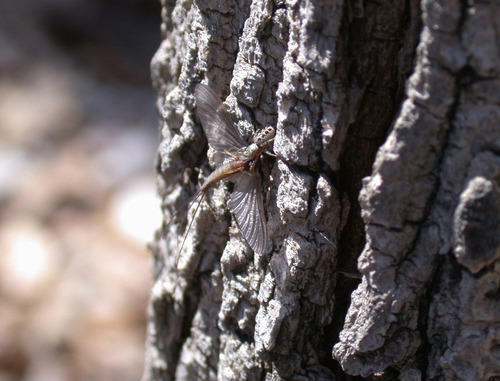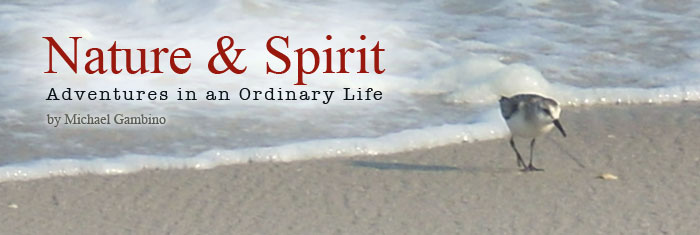Masters of Disguise
 Monday, July 18, 2011 at 05:28PM
Monday, July 18, 2011 at 05:28PM  A spider hidden on tree bark pounces on this unsuspecting Mayfly. This photo illustrates the often unseen drama of nature's predator-prey relationships, as well as evolutionary selection in progress. (Click to enlarge)In nature, avoiding detection is one of the many survival adaptations that organisms have employed to ensure their species lives to see another millennia. Some organisms, such as plants, have no real need to hide. In fact, they try to stand out. They need to find open spaces to grab available sunlight. They produce an amazing variety of flowers to accomplish pollination, and bear tasty fruits, seeds, berries, and nuts to entice animals into dispersing the plant’s genetics far and wide, thus overwhelming the herbivorous creatures that feed on their populations. Their strategies are necessary, and their populations vastly numerous because plants are right at the beginning of the energy cycle, or food chain. As we learned in elementary school, plants capture the photons from the sun and convert it into food for their growing their vegetative bodies.
A spider hidden on tree bark pounces on this unsuspecting Mayfly. This photo illustrates the often unseen drama of nature's predator-prey relationships, as well as evolutionary selection in progress. (Click to enlarge)In nature, avoiding detection is one of the many survival adaptations that organisms have employed to ensure their species lives to see another millennia. Some organisms, such as plants, have no real need to hide. In fact, they try to stand out. They need to find open spaces to grab available sunlight. They produce an amazing variety of flowers to accomplish pollination, and bear tasty fruits, seeds, berries, and nuts to entice animals into dispersing the plant’s genetics far and wide, thus overwhelming the herbivorous creatures that feed on their populations. Their strategies are necessary, and their populations vastly numerous because plants are right at the beginning of the energy cycle, or food chain. As we learned in elementary school, plants capture the photons from the sun and convert it into food for their growing their vegetative bodies.
Many plants have evolved toxic chemical and physical deterrents against browsing animals and insect assault. Sharp, thorn-covered stems and leaves, and poisonous, unpalatable, or caustic plant juices are quite effective at ensuring the opportunity for plant species to successfully grow and reproduce. There are also animals that are passively poisonous or hazardous to ingest (like puffer fish, Poison dart frogs, Monarch butterflies, and Red-efts), though often when we think of poisonous animals we mean venomous animals such as wasps, snakes, jellyfish, spiders, and shrews – those that use their toxins to kill or subdue their food.
Unlike plants, nearly all animals have colors and markings that help them blend into their habitat and deceive would-be predators. Predators at every level in the food chain on land and in the sea must also have patterns, colors, or growth-forms that cloak their deadly mission. There are exceptions to every rule in nature, of course, like brightly-colored animals that advertise their toxicity as a warning (red being the most common “danger” signal).
For me, one of the most exciting things in nature is discovering hidden creatures. Most blend so precisely into their background that when I happen upon them, I gasp in surprise and delight. My photos shown here are but a tiny fraction of what’s out there if you know how to look for them. Some creatures mimic vegetation – bark, leaves, stems, grasses, and flowers; others look like rocks, soil, sand, water, and sky! Some animals that aren’t toxic mimic the shape and color of actual toxic animals to fool predators into thinking they too are not safe to eat. For example, there are beetles that resemble wasps, flies that look like Yellowjackets, (neither the beetle or the fly has venomous stingers), and butterflies that mimic a Monarch’s coloring, basically implying that it too is toxic by association. Many toxic species accumulate lethal alkaloids in their tissues by eating food from their environment that contains those chemicals. So now, a spider has to be more careful about what it pounces on, and a mother Robin must be cautious about what it feeds to her chicks. Perhaps we can now appreciate one reason why the life of a predator is not any easier than it is for creatures sitting lower in the food chain.
All camouflage is a process of natural selection. For example, a white moth that has no more white flowers or white tree bark to hide against (due to diseases or other events killing off the plants) is an easy target for birds, dragonflies, and such. Eventually, the moths with the genes that produce white-colored wing scales will be removed from the gene pool of that habitat, and those moths with more effective camouflaging patterns and colors will live to successfully reproduce generation after generation.
If you want to search for hidden creatures, you need not go looking for Bigfoot or the Loch Ness Monster. You can start by looking closely at tree bark, stone walls, and even outside your home for moths and other insects of the night. They need some place to rest during the day undisturbed until nightfall. You might also take a closer look at shrubs and flower beds during the day for a huge variety of insects.
For larger animals, try spotting deer in the forests and thickets, especially in the fall when the leaf colors are changing and deer exchange their tawny summer color in favor of winter coats that reflect the grays, browns, and whites of the winter woods. Trying to decode the cryptic coloring of wildlife offers an excellent opportunity for training your naturalist observation skills! It takes a bit of patience, but the discoveries are always well worth it.
As you look through these photos, take a moment to really examine the backgrounds and the creature’s markings. Look at the patterns of shadow, light, tone, line, colors, and form of the animal’s background setting. (Click on each photo for larger image).
 1) Monarch caterpillar on Butterfly Weed (a milkweed).
1) Monarch caterpillar on Butterfly Weed (a milkweed). 2) A species of Underwing Moth on a stone wall.
2) A species of Underwing Moth on a stone wall. 3) Salt water, “glass eel” phase of unidentified Atlantic eel.*
3) Salt water, “glass eel” phase of unidentified Atlantic eel.* 4) An adult stinkbug blends-in well on light green plants.
4) An adult stinkbug blends-in well on light green plants. 5) Walkng Stick insects mating on tree bark. Amazing!
5) Walkng Stick insects mating on tree bark. Amazing!
 6) Pickeral Frog’s fantastic pattern against dry wetland grasses.
6) Pickeral Frog’s fantastic pattern against dry wetland grasses. 7) Box Turtle in marshy habitat hiding in shadow and light.
7) Box Turtle in marshy habitat hiding in shadow and light. 8) M & F Gypsy Moths and another well-hidden moth!
8) M & F Gypsy Moths and another well-hidden moth! 9) A woodland snail in its shell blends with forest debris.
9) A woodland snail in its shell blends with forest debris. 10) Grey Squirrel resting on bare tree branch in winter.
10) Grey Squirrel resting on bare tree branch in winter. 11) White-tailed deer in winter coat.
11) White-tailed deer in winter coat. 12) A stinkbug in its nymphal stage hides in autum foliage.
12) A stinkbug in its nymphal stage hides in autum foliage. 13) A species of Notodontid moth rests on a stone wall.
13) A species of Notodontid moth rests on a stone wall. 14) “Lichen morph” caterpillar of a Catacola moth.
14) “Lichen morph” caterpillar of a Catacola moth. 15) Ruffed Grouse chicks in dappled sunlight and debris.
15) Ruffed Grouse chicks in dappled sunlight and debris. 16) Conehead Katydid coloring and shape mimics leaves.
16) Conehead Katydid coloring and shape mimics leaves. 17) A Bullfrog's fine-tuned camouflage.
17) A Bullfrog's fine-tuned camouflage. 18) Nesting birds must hide from predators. Can you see it?
18) Nesting birds must hide from predators. Can you see it? 19) Orchard Orb Weaver spider on bamboo. Beautiful!
19) Orchard Orb Weaver spider on bamboo. Beautiful! 20) A venomous Copperhead in leaf litter. A truly brilliant pattern!
20) A venomous Copperhead in leaf litter. A truly brilliant pattern!
As a reminder, all the photos and artwork on this website are mine and are copyrighted, except if noted otherwise. Thank you!
*(photo of glass eel by Melanie Gambino)

Reader Comments (7)
Dear Michael,
WoW! These are such awesome photos and what amazing finds in nature - captured beautifullly on film! Thanks for sharing these and - of course - the thrill of finding of these awesome "there at the right time" nature wonders!
Many happy trails to you and thans again for sharing!
Thank you so much Michael for sharing these absolutely beautiful photographs! It's always such a pleasure when you remind us to stop running and give us a beautiful visit into your world, and to look at everything around us again. Sooooo beautiful!
Brilliant as usual. Pictures are truly beautiful and subjects are almost invisible. I did find the
third moth with the M &F Gypsy moth (finally).
You are a photographic genius! Guess who!
AMAZING pics! Did you take these yourself? I NEED to have a camera like that!!! Thanks for sharing, and thanks for the Spirit and Nature break............... :-) Don't know if I know enough people to share this with!
Yes photos are taken by me (except the Glass eel taken by my lovely wife). The camera is a Canon PowerShot SD1100 Digital-Elph. Cost about $150 on ebay a few years back.
As for sharing the website with others, you don't need a million people! Just send the link to one of your family members. Remember, we are all part of nature!
Thank you Michael for sharing so much with us. Ah, remarkable...love seeing nature through your eyes and words. xox
Thank you Lee!